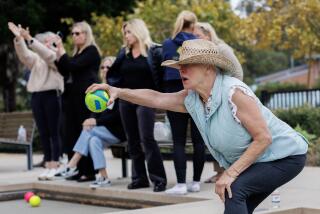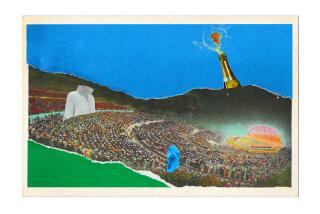Bowled Over by Sporting Game : Thrill of Roll Draws Players to Tournament
- Share via
NEWPORT BEACH — Hot smog hovered above the crew-cut grass at Newport Harbor Lawn Bowling Club on Sunday as Lloyd Kennedy, 31, of Santa Ana found himself face to face with the country’s premier lawn bowler, Neil McInnis, 64, of Glendale.
Kennedy was prepared. He knew McInnis likes to pull his bowling mat up to unnerve his opponent. So Kennedy walked up and down the grass to unnerve him . He also knew McInnis likes to talk. “So I didn’t talk to him,” Kennedy said. If all else failed, he hoped his youthful stamina would give him the edge over the course of a possible eight hours of play in the withering weather.
Welcome to the cutthroat world of competitive lawn bowling.
Hardly anyone knows lawn-bowling tactics like the 450 bowlers gathered in Orange County for the 1991 National Open Lawn Bowling Tournament. The tourney, sponsored by the American Lawn Bowls Assn. and the American Women’s Lawn Bowls Assn., opened Friday with Marine color guard and string quartet ceremonies at the Newport Harbor club. It runs through Friday at nine different lawn bowling clubs throughout Orange County and Long Beach.
Although the $200 first prize would not nearly cover most participants’ travel ex penses, bowlers came from as far away as England and Australia to put on their whites and test their abilities to pitch an oblong bowl along the green and outwit their opponents.
Why? “I love it,” said John Hamill of Kent, England. “The game and the holiday.”
Most of the country’s 6,500 lawn bowlers are in it for fun, said Champ Salisbury, national president of the American Lawn Bowls Assn. About 14 of the top players in the United States are sent to international competition, which they have never won. In between are the players who show up for tournaments such as this one. “People who love to play, but have no aspiration, fools who will spend a couple thousand bucks because we love the competition,” Salisbury said.
The event is now held in California because more than 50% of lawn bowlers in the United States do their bowling here and because it offers the best opportunities for media exposure.
The sport, derived from the Roman game of boccie and popularized in England, would be thriving in the United States “if it were not for the problem we had with the English 200 years ago,” Salisbury said. As evidence of its early popularity, he points to the towns named Bowling Green in such states as Kentucky and Ohio.
As it is, it’s equated with older people, usually seniors who testify to its benefits of socializing and mild exercise. In international competition, Americans typically field the oldest team and usually do no better than about 16th place.
“We’re trying to revive it,” Salisbury said. The association has even appointed an Englishman with a classy hyphenated last name to be marketing director, he observed.
Officials say lawn bowling is a game of intense concentration. Basically, players stand on mats and pitch their 3- to 5-pound bowls toward a smaller white target ball. The object is to end up with your bowls closer to the target than your opponents’. It can be played in teams or singles. Comparing bowling to golf, Salisbury says lawn bowling is like putting, and alley bowling is more like driving.
Judging by the scene Sunday, lawn bowling appears to be a polite game for retired people, sitting quietly on folding chairs around a close-cropped lawn, applauding and commenting, “Well bowled!”
The participants adhere to a code of etiquette, including handshakes and wishes of “good bowling” before a match. In some countries dress codes require a tie.
So an unschooled observer might not spot the less sporting behavior--the untimely cough, the unnecessary measuring or moving your mat closer to the ball. Santa Ana’s Kennedy said he offers his opponents unsolicited advice on what they did wrong. Sometimes, it might even be true, he said.
In other countries, lawn bowling has the enthusiastic following, the television coverage, the clubby bars and the sponsors accorded to tennis or golf in this country.
Australia, for instance, claims about 300,000 players, including 20 instructors who earn more than $100,000 (that’s in U.S. dollars) per year, said marketing director Michael Ashton-Phillips. Every little town in New Zealand has a sign pointing to the green, Salisbury said.
There are as many lawn bowlers in Auckland, New Zealand, alone as in the entire United States, he said. That city has 95 lawn-bowling clubs.
Lawn bowling’s sedate image will change when “the money comes,” Ashton-Phillips says. He has been trying to work with hotel and golf course developers to include bowling greens. One developer agreed, he said, but then the corporation was sold to the Japanese, who said no.
Ashton-Phillips, the son of an English lawn bowler, dreams of 100,000 members, 500 clubs, indoor clubs, better greens, television coverage and world bowls to be held in the United States.
Then, he said lawn bowling may even produce a John McEnroe of its own.
More to Read
Go beyond the scoreboard
Get the latest on L.A.'s teams in the daily Sports Report newsletter.
You may occasionally receive promotional content from the Los Angeles Times.










